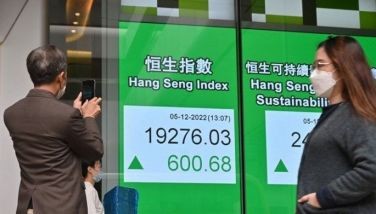Fitch Ratings sending team to review Phl performance
MANILA, Philippines - Global credit rater Fitch Ratings is sending a review team to the Philippines this month to discuss plans of the Aquino government and at the same time assess the country’s economic and fiscal situation.
The visiting team scheduled to arrive in the last week of March would be composed of Fitch head of Asia Pacific Sovereigns Andrew Colquhoun and Fitch managing director and chief operating officer for Global Sovereigns Rating Tony Stringer.
The visitors are scheduled to make a courtesy call to Bangko Sentral Governor Amando M. Tetangco Jr.
The team would also meet with officials of the Department of Finance, Department of Budget and Management, Department of Tourism, Department of Trade and Industry, National Economic and Development Authority, the Philippine Economic Zone Authority, and the newly-established Public Private Partnership (PPP) Center.
The visiting analysts are also scheduled to meet with revenue generating agencies led by the Bureau of Internal Revenue, Bureau of Customs, and the Bureau of Treasury.
Aside from government officials, Colquhuon and Stringer are expected to meet with officials of the US Embassy, multilateral lenders International Monetary Fund and Asian Development Bank as well as the private sector led by the American Chamber of Commerce, Business Processing Association of the Philippines, among others.
High on the agenda is the country’s economic performance and fiscal situation as well as the plans of the Aquino administration in addressing the government’s budget deficit.
The Philippines posted its strongest economic growth in 34 years after its gross domestic product (GDP) growth zoomed to 7.3 percent last year from 1.1 percent in 2009. This exceeded the government’s revised GDP growth target of five percent to six percent.
This year, the Cabinet-level Development Budget Coordination Committee (DBCC) has set a GDP growth target of between seven percent and eight percent.
Despite the strong economic growth, the Philippines posted a record budget deficit of about P310 billion or 3.2 percent of GDP last year from P298.5 billion or 3.9 percent of GDP in 2009.
In 2011, the government hopes to trim the budget deficit to P290 billion or 3.2 percent of GDP as the Aquino administration has committed to reduce the deficit to two percent of GDP starting 2013 until 2016.
Monetary and fiscal authorities of the Aquino government are confident of a possible rating upgrade from Fitch Ratings after getting an upgrade from Moody’s Investors Service last January and Standard and Poor’s last November.
Fitch Ratings has pegged the Philippines long-term foreign currency rating at BB or two notches below investment grade with a stable outlook.
Last August, the global credit rating agency pointed out that public finances remain the country’s key rating weakness as its revenue-to-GDP ratio remain well below the median of 21 percent for BB range countries and cited the need for the Aquino government to raise revenues and maintain fiscal discipline this year.
However, Fitch Ratings commended the country’s economic resiliency on the back of strong consumption, benign inflation environment and strengthening external payments position.
The BSP sees inflation averaging 4.4 percent this year from 3.8 percent last year despite the build up of inflation pressures on the back of rising global oil and food prices.
The BSP’s Monetary Board has kept its overnight borrowing rate at a record low of four percent and its overnight lending rate at six percent since July 2009 but monetary authorities hinted of a possible rate hike during its second policy setting meeting this year scheduled on March 24. The central banks slashed its key policy rates by 200 basis points between December 2008 to July 2009 to cushion the impact of the global financial crisis on the domestic economy.
Monetary authorities see stronger external payments position to further strengthen this year with the gross international reserves (GIR) hitting a record level of between $68 billion and $70 billion and the balance of payments (BOP) surplus ranging from $6 billion to $8 billion. The country’s GIR stood at a record level of $62.3 billion while the BOP surplus at an all-time high of $14.4 billion last year.
- Latest
- Trending


























